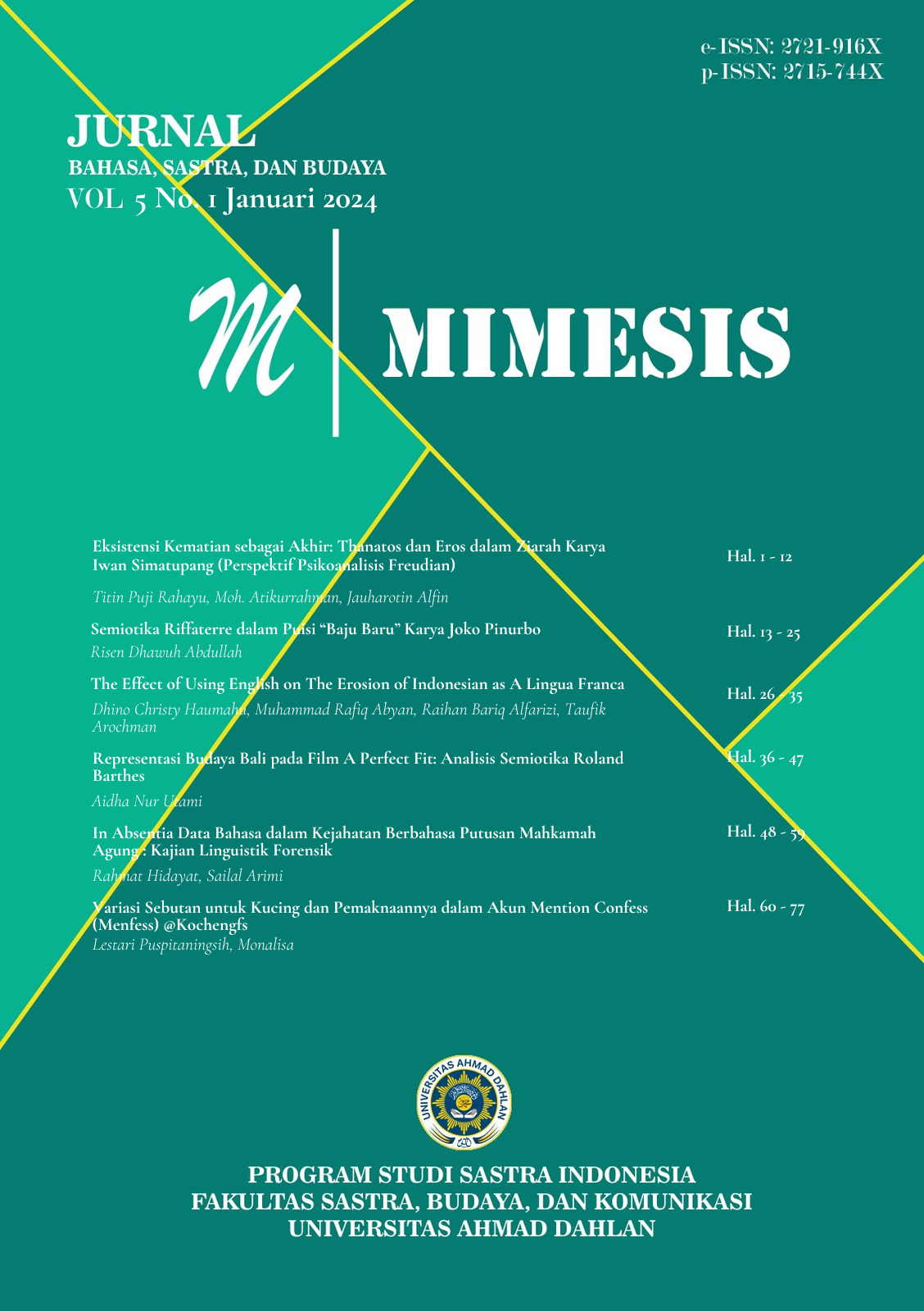The Effect of Using English on The Erosion of Indonesian as A Lingua Franca
DOI:
https://doi.org/10.12928/mms.v5i1.9297Keywords:
English, Erosion, Indonesian, Lingua FrancaAbstract
This research aims to determine the influence of the use of English as a language of daily communication on the erosion of Indonesian as a lingua franca, by considering various sociolinguistic and cultural factors. Indonesian is the national language used by Indonesian people to this day. However, the use of Indonesian seems to be starting to be eroded by the use of English which is recently frequently used, especially by teenagers. This raises growing concerns about its potential impact on the erosion of Indonesian, the lingua franca. This study involves the theory of extensive utilization of the English language in various fields and its current status as a global or international language. The method used in this research was descriptive qualitative. Qualitative data were collected through surveys, online forms, and focus group discussions with individuals representing different linguistic backgrounds and levels of English proficiency. The results of this research showed that 96.2% of respondents always use English as their daily language in communication. Apart from that, the use of English had an impact on the use of Indonesian when having a conversation. Researchers also found that even though respondents knew Indonesian as a lingua franca, in fact they used English more by 51.9%. Therefore, this research also seeks to provide input for language planning and language policy making which aims to maintain the national language and preserve the role of Indonesian as an important communication tool in Indonesian society.
References
Agusto, L. M. (2021). From symbols to knowledge systems: A. Newell and H. A. Simon's contribution to symbolic AI. Journal of Knowledge Structures and Systems 2(1), 29-62.
Aini, N., Amalia, F., & Ningrum, A. (2022). Improving Students' Speaking Skill Using Hello English Application as a Medium of Learning from Home. IDEAS: Journal on English Language Teaching and Learning, Linguistics and Literature, 10(1), 730-745. doi:https://doi.org/10.24256/ideas.v10i1.2533
Anggraini, A., Yastanti, U., & Faisal, F. (2023). Improving Student Speaking Skills Using the Hello English Application. Journey: Journal of English Language and Pedagogy, 6(1), 265-271. https://doi.org/10.33503/journey.v6i1.2692
Apriyani, T. & Nalurita, B. A. Y. (2023). Nilai Kebangsaan pada Karya-Karya Leila S. Chudori. Diglosia: Jurnal Kajian Bahasa, Sastra, dan Pengajarannya 6(2), 375-388. https://doi.org/10.30872/diglosia.v6i2.594
Arochman, T., Jabbar, S. A., Hutabarat, P. S. P., & Pitaloka, N. S. A. (2023). Infographics as a Tool to Facilitate English Learning Activities: Student’s Perceptions. ENGLISH FRANCA: Academic Journal of English Language and Education, 7(2), 369–382. https://doi.org/10.29240/ef.v621.5242
Arochman, T., Malasari, S., & Yunianti, S. S. (2023). The Effect of ELITA on English Writing Learning for College Students. VELES (Voices of English Language Education Society), 7(1), 75–85. https://doi.org/10.29408/veles.v7i1.7524
Bolden, G. B., Hepburn, A., & Mandelbaum, J. (2023). The distinctive uses of right in British and American English interaction. Journal of Pragmatics, 205, 78-91. https://doi.org/10.1016/j.pragma.2022.12.017
Creswell, J. W. (2015). Educational research: Planning, conducting, and evaluating quantitative and qualitative research (5th ed.). Boston: Pearson.
Delimasari, A., Fauziah, N., Anjarsari, D. P., & Arochman, T. (2023). Classroom’s Environment and FOMO: Students’ Perspectives. IDEAS: Journal on English Language Teaching and Learning, Linguistics and Literature, 11(2), 1494–1506. https://doi.org/10.24256/ideas.v11i2.3941
Fitriani, S. (2019). A Child Language Acquisition in Indonesian and English Language: A Longitudinal case study. Register Journal, 12(2), 126-156. https://doi.org/10.18326/rgt.v12i2.126-156
Gunantar, D. A. (2016). The impact of English as an international language on English Language Teaching in Indonesia. Language Circle: Journal of Language and Literature, 10(2), 141-151. https://doi.org/10.15294/lc.v10i2.5621
Hessel, A. K. & Strand, S. (2023). Proficiency in English is a better predictor of educational achievement than English as an Additional Language (EAL). Educational Review, 75(4), 763-786. https://doi.org/10.1080/00131911.2021.1949266
Inayati, N., Saputro, T. H., & Kebble, P. (2021). Indonesian English Teachers’ Perceptions of Learning and Teaching Materials based upon the Notion of English as International Language. The Journal of English as an International Language, 16(2), 1-22.
Jon, R. B., Embong, R., Purnama, B., & Wadi, A.S. (2021). The Challenges of English Language Teaching in Indonesia. International Journal of English and Applied Linguistics (IJEAL), 1(3), 158-168. https://doi.org/10.47709/ijeal.v1i3.1157
Kertiasih, N. N. (2018). Bahasa Indonesia dan nasionalisme di Indonesia. KULTURISTIK: Jurnal Bahasa dan Budaya, 2(2), 187-192. https://doi.org/10.22225/kulturistik.2.2.808
Leavy, P. (2023). Research Design Quantitative, Qualitative, Mixed Methods, Art-Based, and Community-Based Participatory Research Approaches (2nd Ed). New York: The Guilford Press.
Lee, J. S., Lee, K., Drajati, N. A. (2019). Preservice English teachers’ perceptions of English as an international language in Indonesia and Korea. Journal of Multilingual and Multicultural Development, 40(3), 230-243. https://doi.org/10.1080/01434632.2018.1503669
Matsuda, A. & Friedrich, P. (2011). English as an international language: A curriculum blueprint. World Englishes, 30(3), 332-344. https://doi.org/10.1111/j.1467-971X.2011.01717.x
McKay, S. L. (2018). English As an International Language: What It Is and What It Means for Pedagogy. RELC Journal, 49(1), 9-23. https://doi.org/10.1177/0033688217738817
Moleong, L. J. (2010). Metodologi Penelitian Kualitatif. Bandung: PT Remaja Rosdakarya.
Murtisari, E. T. & Mali, C. G. (2017). Impact of English on the Indonesian language and culture: High school students’ perceptions. Studies About Languages, 30. https://doi.org/10.5755/j01.sal.0.30.17570
Nuryanto, T. (2015). Menurunnya Penutur Bahasa Indonesia Sebagai Lingua Franca. Al Ibtida: Jurnal Pendidikan Guru MI, 2(2), 1-12. https://doi.org/10.24235/al.ibtida.snj.v2i2.124
Nuryanto, T. (2015). Menurunnya Penutur Bahasa Indonesia Sebagai Lingua Franca. Indonesian Language Education and Literature, 1(1), 42-60. https://doi.org/10.24235/ileal.v1i1.50
Parker, L., & Hoon, C. Y. (2014). Education for a tolerant and multicultural Indonesia: Introduction. South East Asia Research, 22(4), 459-465. https://doi.org/10.5367/sear.2014.0229
Sa'diyah, I., Ariffa, A. H., Agustina, E., Maghfiroh, M., & Kusnarto, K. (2023). Penggunaan Bahasa pada Perkembangan Industri Pariwisata di Surabaya: Studi Kasus Objek Wisata Museum Sepuluh Nopember. Mimesis, 4(2), 143-152. https://doi.org/10.12928/mms.v4i2.8072
Tan, K. H., Farashaiyan, A., Sahragard, R., & Faryabi, F. (2020). Implications of English as an international language for language pedagogy. International Journal of Higher Education, 9(1), 22-31. https://doi.org/10.5430/ijhe.v9n1p22
Wahyuningsih, L., Huwaidah, H. K., Maryam, F. F. D., & Arochman, T. (2023). Learners Strategies Used by Non-English Department Students in Learning English: Students’ Perspective. KABASTRA: Kajian Bahasa Dan Sastra, 3(1), 12–22. https://doi.org/10.31002/kabastra.v3i1.1083
Zhang, J. & Liu, M. (2022). An Investigation of Culture Presentation in ELT Textbooks in the Context of English as an International Language. Journal of Language Teaching and Research, 13(4), 884-890. https://doi.org/10.17507/jltr.1304.21
Downloads
Published
Issue
Section
License
Copyright (c) 2024 Dhino Christy Haumahu, Muhammad Rafiq Abyan, Raihan Bariq Alfarizi, Taufik Arochman

This work is licensed under a Creative Commons Attribution-ShareAlike 4.0 International License.
License and Copyright Agreement
In submitting the manuscript to the journal, the authors certify that:
- They are authorized by their co-authors to enter into these arrangements.
- The work described has not been formally published before, except in the form of an abstract or as part of a published lecture, review, thesis, or overlay journal.
- That it is not under consideration for publication elsewhere,
- That its publication has been approved by all the author(s) and by the responsible authorities tacitly or explicitly of the institutes where the work has been carried out.
- They secure the right to reproduce any material that has already been published or copyrighted elsewhere.
- They agree to the following license and copyright agreement.
Copyright
Authors who publish with Mimesis agree to the following terms:
- Authors retain copyright and grant the journal right of first publication with the work simultaneously licensed under a Creative Commons Attribution License (CC BY-SA 4.0) that allows others to share the work with an acknowledgment of the work's authorship and initial publication in this journal.
- Authors are able to enter into separate, additional contractual arrangements for the non-exclusive distribution of the journal's published version of the work (e.g., post it to an institutional repository or publish it in a book), with an acknowledgment of its initial publication in this journal.
- Authors are permitted and encouraged to post their work online (e.g., in institutional repositories or on their website) prior to and during the submission process, as it can lead to productive exchanges, as well as earlier and greater citation of published work.











